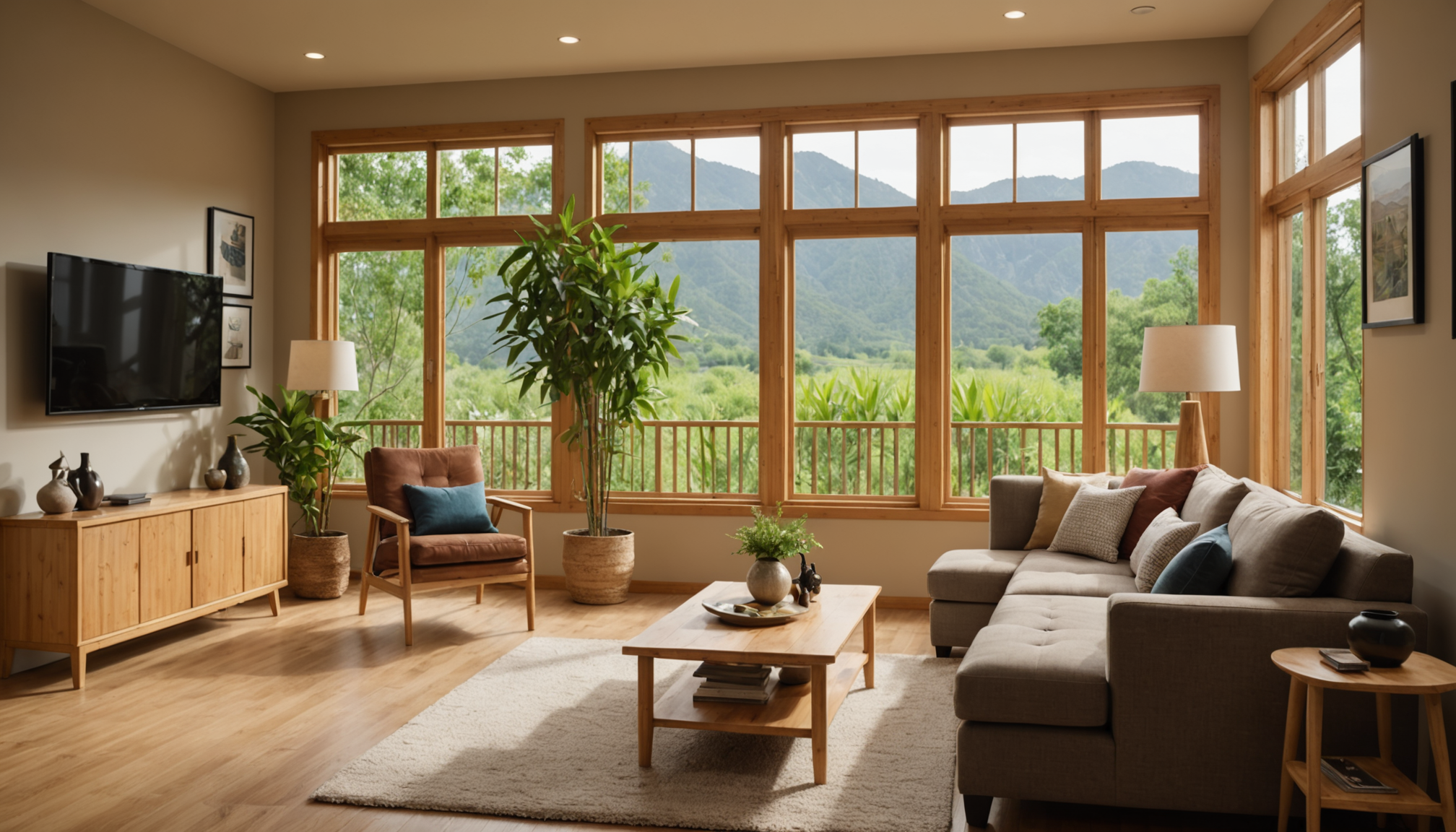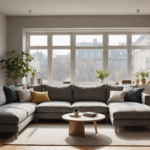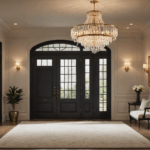As we move toward the future, the trend of sustainable living spaces is more dominant in architecture and interior design than ever before. Homeowners and designers alike are recognizing the environmental and economic benefits of creating residences that not only look good but are also considerate of our planet’s resources. This commitment to sustainability is manifesting in several key areas.
Firstly, the utilization of renewable resources is at the forefront. Materials such as bamboo, recycled wood, and reclaimed steel are being employed in various facets of home construction and decor. Bamboo, for example, is celebrated for its rapid growth and versatility, making it an ideal choice for flooring, wall paneling, and furniture. Recycled wood and steel provide a unique, rustic aesthetic while reducing the demand for new raw materials.
Furthermore, energy efficiency remains a critical component of sustainable living spaces. Modern homes are being equipped with advanced insulation techniques, energy-efficient windows, and smart thermostats to reduce energy consumption effectively. Solar panels are being increasingly integrated into home designs, offering a renewable energy source that decreases reliance on traditional power grids.
- Renewable Resources: Bamboo, recycled wood, reclaimed steel
- Energy Efficiency: Advanced insulation, energy-efficient windows, smart thermostats, solar panels
The emphasis on sustainability is also evident in water conservation practices. Rainwater harvesting systems and greywater recycling options are becoming standard features in sustainable home design. These systems not only conserve water but also decrease water bills, demonstrating that eco-friendly solutions can be economically beneficial as well.
- Water Conservation: Rainwater harvesting, greywater recycling
Even the selection of household appliances plays a role in the sustainability movement. Opting for Energy Star-rated appliances ensures minimal energy consumption, while low-flow toilets and fixtures reduce water use. This holistic approach to home design underscores a commitment to environmental stewardship without compromising on style and comfort.
| Aspect | Benefits |
| Renewable Resources | Reduces demand for raw materials, sustainable growth, unique aesthetics |
| Energy Efficiency | Lower energy bills, reduced carbon footprint |
| Water Conservation | Lower water bills, sustainable water use |
| Eco-friendly Appliances | Lowers energy and water usage, cost-effective in the long run |
Ultimately, the shift toward sustainable living spaces is much more than a design trend; it’s a lifestyle choice that aligns with growing concerns about climate change and resource scarcity. As society becomes increasingly aware of these issues, the demand for homes that support sustainable living is expected to rise, pushing designers and builders to continually innovate in this important domain.
Smart home innovations
As technology continues to advance, integrating smart features into homes is becoming more seamless and prevalent. The latest innovations are designed not only to enhance convenience and efficiency but also to improve the overall quality of life for homeowners. Here’s a closer look at how these advancements are reshaping modern living spaces:
1. Smart Climate Control: Managing a home’s climate is now more intuitive and efficient with AI-powered thermostats. These devices learn the habits and preferences of the household over time, adjusting the temperature automatically to ensure maximum comfort while minimizing energy use. To implement smart climate control:
– Install a smart thermostat and connect it to the home Wi-Fi network.
– Set preferences manually or allow the AI to learn over a period.
– Benefit from remote control via smartphone apps, which allow for adjustments even when you’re away from home.
2. Voice-Activated Assistants: Voice technology has become a staple in many homes, facilitating hands-free control of various systems:
– Choose a reliable AI assistant platform (such as Alexa, Google Assistant, or Apple’s Siri) and set up compatible devices.
– Use voice commands to control lighting, music, and appliances, enhancing convenience with a simple “Turn on the lights” or “Play my favorite song.”
– Ensure seamless connection across devices for an integrated smart home experience.
3. Advanced Security Systems: Safety features have evolved beyond traditional lock and key mechanisms. Modern systems offer:
– Smart locks that allow access through digital keys or biometric scanning.
– Install security cameras with facial recognition and motion sensors that alert homeowners to unusual activity.
– Connect with mobile apps to monitor home security remotely, providing peace of mind while away.
4. Intelligent Lighting Systems: Tailor indoor ambiance through smart lighting options:
– Implement LED bulbs that can change color and intensity, controlled via smartphones or voice commands.
– Program lighting schedules that align with daily routines to simulate natural light patterns, enhancing mood and productivity.
– Reduce energy consumption by automatically turning off lights in unoccupied rooms.
5. Integrated Multimedia: Create an immersive entertainment environment with:
– Smart televisions and audio systems that integrate with streaming services for easy access to content.
– Utilize multi-room audio solutions that sync music across different areas of the house.
– Control systems through centralized apps, offering a cohesive and personalized media experience.
6. Efficient Resource Management: Smart technologies contribute significantly to resource conservation:
– Water leak sensors that send alerts directly to your phone can prevent wastage and damage.
– Smart irrigation systems that adjust watering schedules based on weather forecasts, ensuring optimal water use in gardens and lawns.
– Track energy consumption using smart meters, identifying opportunities to reduce usage and enhance sustainability.
By integrating these innovations, homes not only become more efficient and secure but also adapt to the changing lifestyles and needs of their inhabitants. These advancements are not merely a convenience; they represent the future of participatory living, where technology harmonizes with daily life to bring about a new standard of luxury and efficiency.
Organic textures and materials
The growing appreciation for organic textures and materials in home design reflects a deeper connection to nature and a desire for authenticity in our living spaces. This trend showcases a harmonious blend of aesthetics and functionality, offering homeowners an opportunity to infuse their spaces with warmth and personality.
Incorporating natural materials such as wood, stone, and clay into home interiors evokes a sense of timelessness and tranquility. Each piece brings a unique story, with natural grains and patterns that can’t be replicated by artificial materials. The tactile and visual qualities of these elements create an environment that is both grounding and inviting. Wood, for instance, is not only versatile but also durable, making it ideal for flooring and furniture that exudes a classic charm. Stone accents, whether as countertops or feature walls, add texture and depth, suggesting a rustic elegance that complements a wide variety of interior styles.
Textiles also play a significant role in this trend, with organic fibers like cotton, wool, and linen being favored for their sustainability and comfort. These materials offer a soft, breathable quality that’s perfect for creating cozy spaces. Incorporating throws, cushions, and rugs made from organic fibers can enhance the tactile experience of a room, making it feel more lived-in and personal. Handcrafted items crafted from these materials also support artisanal traditions and local economies, adding a layer of cultural richness and ethical sourcing to the design philosophy.
Moreover, incorporating natural finishes enhances the organic appeal. Unpainted wood with a clear sealant or oil finish showcases its inherent beauty while providing necessary protection. Lime wash and clay-based paints contribute to healthier indoor air quality due to their low VOC content. These finishes add a subtle, matte texture that enhances the natural light in a room, offering a soft, diffused glow rather than harsh reflections.
Biophilic design, which emphasizes a strong connection between indoor and outdoor environments, is another integral aspect of this trend. By integrating elements like living walls, indoor plants, and water features, homes embrace the calming influence of nature. Plants not only improve air quality but also enliven spaces with their vibrant hues and dynamic shapes. This connection to nature invites an atmosphere of relaxation and well-being, transforming homes into serene retreats.
The preference for organic textures and materials is more than just a stylistic choice; it contributes significantly to increased psychological and emotional well-being. Natural aesthetics promote a calming and restorative environment, which can reduce stress and improve mood. By aligning more closely to the natural world, homeowners can create spaces that feel harmonious and nurturing, reinforcing a sense of belonging and tranquility.
By embracing organic textures and materials, homeowners have the ability to create distinctly personal spaces that reflect their individual tastes while maintaining a commitment to environmental consciousness. This trend highlights the importance of tactile experiences and the beauty of imperfection, celebrating the inherent beauty of the natural world within the fabric of everyday life.
Indoor-outdoor integration
The blurring of boundaries between indoor and outdoor spaces has captured the fascination of both homeowners and designers in recent years, and this trend is poised to become even more pronounced. The goal is to create seamless transitions that encourage a harmonious flow between inside and outside areas, enhancing the living experience by bringing the best of nature into everyday life.
Large, expansive windows and glass doors are instrumental in achieving this fusion. They not only increase natural light within homes but also frame views of the garden, patio, or landscape beyond, allowing occupants to enjoy the scenery regardless of the weather. Sliding or folding glass panels can transform a living room into an open-air pavilion, ideal for entertaining or simply basking in the fresh air. As barriers between the interior and exterior diminish, homes become extensions of their surrounding environments, promoting a sense of unity and openness.
The inclusion of outdoor living areas such as patios, terraces, and decks, often furnished with elements typical of indoor settings like comfortable sofas, dining tables, and outdoor kitchens, extends functional square footage. These spaces serve as ideal locations for relaxing, cooking, or dining al fresco, effectively expanding the home’s livable area. Weather-resistant materials and furnishings ensure durability, while the addition of features like fireplaces or heaters can make these spaces usable throughout various seasons, adding warmth and coziness even in cooler months.
Landscaping plays a critical role in tying together indoor and outdoor spaces. Utilizing native plants that are well-suited to the local climate reduces maintenance and supports local ecosystems. Plant selections such as grasses, shrubs, and flowering perennials provide visual continuity between a home’s interior and its exterior setting. Vertical gardens and green roofs contribute to this integration, offering lush, green scapes that can be viewed from inside and outside alike, optimizing spatial aesthetics and environmental benefits.
Additionally, integrating water features like fountains, ponds, or waterfalls into outdoor design can further enhance the connection to nature. The gentle sound of flowing water adds a calming ambiance, creating a peaceful atmosphere conducive to relaxation and meditation. These features can be strategically placed so that they are visible and audible from within the home, offering a sensory link to the natural world beyond walls.
Lighting is another key element that marries interior and exterior spaces. Thoughtful lighting design ensures these areas remain functional and inviting even after dark. Use of soft ambient lighting, such as string lights or lanterns, creates an enchanting and inviting atmosphere, while path lights and embedded lighting in staircases and walkways offer safety and guide movements through the space.
Ultimately, the integration of indoor and outdoor spaces is not just about enhancing aesthetic appeal; it fosters a holistic lifestyle that embraces nature’s influence. By erasing the line between inside and out, homeowners can enjoy increased flexibility and connection to their surroundings, improving both the functionality and serenity of their living environments. This approach not only maximizes the usable area of a property but also nurtures a deeper appreciation for the natural world, encouraging sustainable living practices and an enduring sense of well-being.
Color palettes and patterns
As we step into 2025, the emerging color palettes and patterns promise to add vibrancy and fresh perspectives to home design. The nuanced use of color not only transforms a room’s ambiance but also influences emotions and experiences, making it a vital component of interior design.
This year, homeowners and designers are gravitating towards colors that reflect nature and evoke a sense of serenity and balance. Earthy tones such as terracotta, olive green, and warm sandy beiges are becoming popular choices. These colors bring an organic warmth and can seamlessly integrate with natural elements like wood and stone. Using these hues on walls, furniture, or accent pieces contributes to creating a calm and inviting atmosphere.
Simultaneously, bold, rich colors are being embraced to add depth and the element of surprise to spaces. Jewel tones like sapphire blue, emerald green, and amethyst purple are making a significant comeback. These intense shades can be used strategically to create focal points or feature walls, complementing more understated elements and balancing the overall vibe of the room.
Patterns, too, are taking on an exciting role in home design. From wallpaper to textiles and tiles, designers are incorporating bold geometric shapes and organic motifs to add visual interest and express individuality. Geometric patterns in monochromatic colors can provide a modern and sophisticated look, while floral and botanical patterns nod to the timeless appeal of nature, adding an organic touch to contemporary settings. Mixing and matching these patterns can be a powerful way to inject energy and character into spaces.
Textural contrast is another dynamic aspect of 2025’s trends, with designers employing a variety of finishes and materials to heighten sensory experiences. Matte finishes, glossy surfaces, and metallic accents are layered to create visual and tactile intrigue. This layering of textures is increasingly regarded as a method to introduce complexity and dimension, mirroring the multifaceted nature of human experience.
The underlying theme of these emerging trends is personalization. The color palettes and patterns for 2025 provide an expansive toolbox for homeowners to craft bespoke environments that resonate with their personal stories and preferences. By experimenting with varied hues, integrating diverse patterns, and thoughtfully considering textures, individuals can create distinctive homes that not only align with contemporary design trends but are also tailored uniquely to their tastes.
In conclusion, the diverse design trends of 2025—from sustainable living spaces to smart home innovations, organic materials to indoor-outdoor integration, and expressive color palettes—reflect a collective yearning for harmony, personalization, and a deeper connection to both nature and technology. These design evolutions not only enhance the visual appeal and functionality of our homes but also embody a thoughtful approach to how we live, interact, and engage with our environments. As we embrace these trends, homes will continue to evolve into spaces that nurture our souls, reflect our identities, and sustain our planet.


